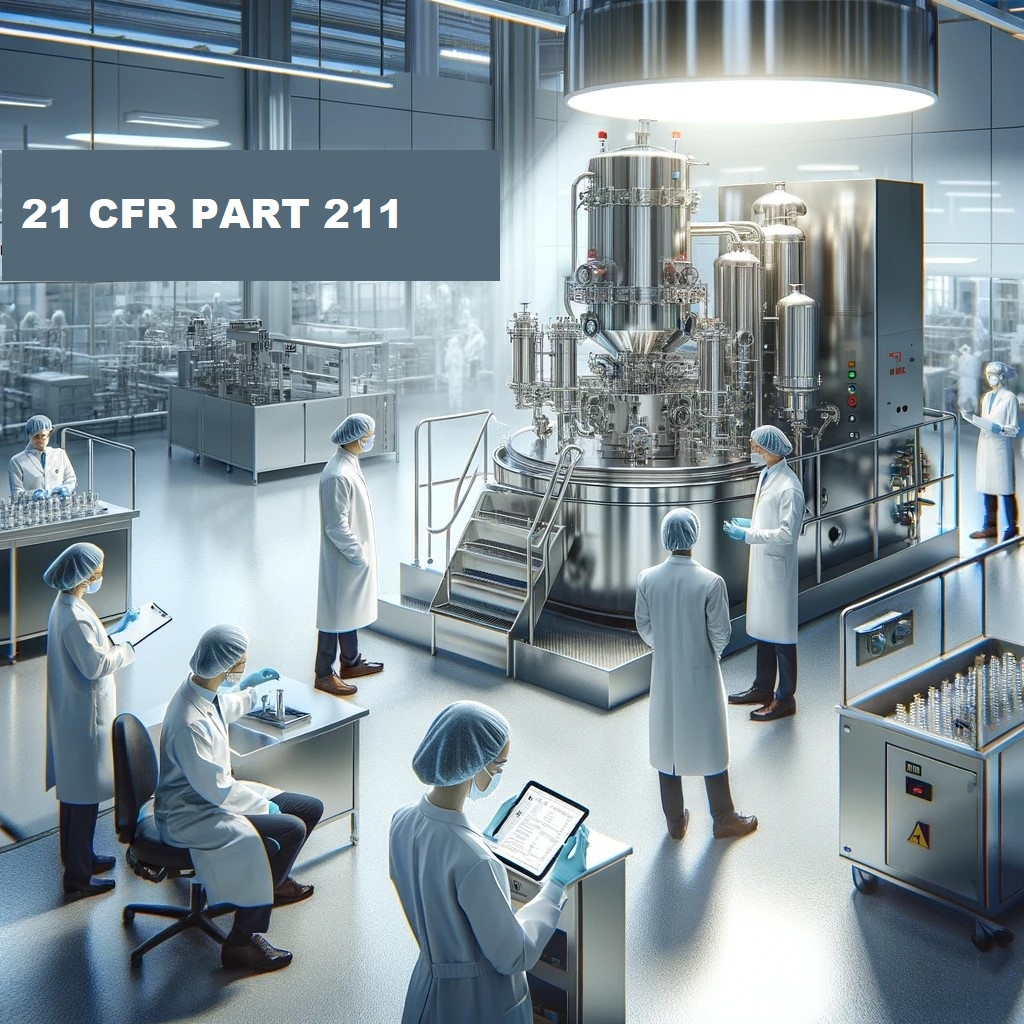What is FDA 21 CFR Part 211 ?
Introduction: 21 CFR 211 compliance is your organization’s stepping stone to meeting the FDA’s definition of current good manufacturing practice (cGMP). Complying with 21 CFR 211 proves that your business has a safe, effective, consistent and quality-managed drug manufacturing operation in place.
FDA 21 CFR Part 211, also known as the Current Good Manufacturing Practice (CGMP) for Finished Pharmaceuticals, is a set of regulations established by the U.S. Food and Drug Administration (FDA). It outlines the requirements for the manufacturing, processing, packing, and storing of drug products to ensure their safety, identity, strength, quality, and purity. It is the gold standard for pharmaceutical manufacturing practices in the United States. Compliance with these regulations is required for pharmaceutical companies to obtain and maintain FDA approval for their products.
Complying with 21 CFR Part 211 and its controls over computerized system ensures compliance with U.S. regulations and facilitates international market access and acceptance.
An FDA data integrity inspection of a drug manufacturing facility focuses on computer systems validations, computer generated, time-stamped audit trails, ability for FDA to inspect, review, and copy records and proper records retention based on “a justified and documented risk assessment and a determination of the value of the records over time.”

How 21 CFR Part 211 controls over Computerized Systems ?
21 CFR Part 211.68 mandates rigorous controls over computerized systems in pharmaceutical manufacturing to ensure the integrity and security of production and control records. This regulation is crucial for maintaining the quality and safety of pharmaceutical products.
21 CFR Part 211.68 revolves around ensuring the integrity and security of data within computerized systems used in the manufacturing and control of pharmaceutical products. It mandates strict controls over these systems to ensure that only authorized personnel can make changes to critical records, such as master production and control records. The regulation emphasizes the importance of verifying the accuracy of data entered into and outputted from these systems, with the extent and frequency of these verifications being tailored to the system’s complexity and reliability.
Furthermore, it requires the maintenance of backup files for data inputted into these systems to safeguard against data loss, except in cases where data, like certain calculations related to laboratory analyses, are rendered unnecessary by the computerization process. In such scenarios, it’s important to keep a written record of the computer program alongside relevant validation data to demonstrate its accuracy and reliability. To ensure the integrity of the backup data, the regulation specifies that hard copies or alternative storage methods (e.g., duplicates, tapes, microfilm) must be used. These should be designed to guarantee that the backup is exact, complete, and protected against unauthorized alterations, accidental erasures, or loss.
How 211.68 works with Vial Filling M/C Production Data and Records?
Imagine a vial filling machine used in a pharmaceutical, responsible for accurately dispensing a liquid drug into vials. This machine is controlled by a computer system that manages the operation parameters, records production data (like batch numbers, fill volumes, and production dates), and ensures that the product meets quality standards.
Compliance with these below requirements ensures that the vial filling process is reliable, consistent, and up to the standards expected by regulatory authorities, ultimately safeguarding patient safety.
- Only individuals with authorized access can make operational changes to the machine, preventing unauthorized modifications.
- Regular verification of the accuracy of both input (like fill volume) and output data (such as production data) to ensure product quality.
- The need for these verifications depends on the system’s complexity and reliability, with critical parameters requiring stringent oversight.
- Keeping backups of all production data to prevent data loss, including detailed batch records.
- Ensuring backups are exact, complete, and secure against alterations or loss.
- Maintaining documentation for any data not stored due to direct management by the computerized system, including validation of the computer program.
What is ALCOA and ALCOA+ Principles?
ALCOA stands for the original five principles which ensure data integrity in the life sciences sector. It has been introduced by USFDA- Its significance spans a broad spectrum of activities, notably in pharmaceutical research, production, testing, and logistics.
It talks about data. Whereas data is facts, figures, and statistics generated / collected during the GXP activity. Data includes all original records, true copies, source data, metadata, reports which are record during the GXP activity.
- ALCOA stands for Attributable, Legible, Contemporaneous, Original, And Accurate. But now, ALCOA is old and ALCOA+ is the updated concept.
- This “+” includes Complete, Consistent,Available and Enduring,
- Many of Pharma industry and regulatory bodies like FDA, WHO follow this concept.
The ALCOA framework is essential for ensuring the data integrity of different GMP records
- Electronically recorded data captured via equipment ranging from straightforward machinery to intricate, highly customizable computerized systems.
- Paper-Based records involves the manual jotting down of observations or activities on paper.
- Hybrid Records is a combination of paper-based and electronic records that together form the original record.
- Other Formats extends to photographs, images, chromatography plates, and beyond, covering a diverse array of data recording methods.ludes
ALCOA+ Principles:
21CFR Part 11 focuses specifically on electronic records and signatures, in practice it is part of the good manufacturing practices (GMP) explained in 21 CFR Part 211. For example, in their data integrity criteria Part 11 and Part 211 links to ALCOA: attributable, legible, contemporaneously recorded, original, and accurate. Lets understand ALCOA + Principle in detail.
Attributable (Who, when, what and why?)
- To make data attributable, it’s essential to record who or what collected, generated, or updated it, its source, and when this happened, regardless of whether the process was automatic or manual.
- Attributability isn’t a technical hurdle since most systems, new and old, can track these details. The real challenge lies in implementing effective procedures and policies, like ensuring password integrity to prevent multiple users from using the same password, which compromises data attributability.
Legible (Readable and permanent?)
- Ensuring data legibility goes beyond simple readability, crucial for both manual and electronic records. While modern digital formats largely solve readability issues, the long-term understanding of data remains vital.
- Data must remain accessible and comprehensible, potentially years after its creation, making the avoidance of complex jargon and consistent use of clear language across an organization essential. Additionally, it’s important that all data, whether collected or updated, is permanent, ensuring its future usability.
Contemporaneous (At the right time?)
- Recording data promptly when an action occurs is crucial. Contemporaneous means that data is current i.e. applicable at the time of its access and recorded in real-time. It means that there should not be any delay between data generation and data recording.
- Contemporaneous recording is particularly vital in manual record-keeping to prevent future-dated entries, which can lead to errors, omissions, and inaccuracies.
- Document should have date of creation, date of revision and effective by, date of recording, correction and review dates.
Original (Unaltered state and ‘true copy’?)
- Original means that data, once recorded, cannot be edited, altered, or erased
- Records must be original, not copies or transcriptions, especially in manual record-keeping. Writing information temporarily on unofficial mediums can lead to errors.
- Data should be initially recorded in its primary form, on paper or digitally, with measures in place to prevent alterations to original digital records. Analyses, reports, or calculations must trace back to their original data sources. Copies of original records need formal verification as true copies and must be clearly differentiated from the originals, which should also be preserved alongside any copies.
Accurate: (Is it the right value/action?)
- Accurate means that data can be relied upon to be true, valid, and correct.
- Accurate records must truthfully represent events, free from errors, without altering original data in a way that obscures it. Necessary amendments should be documented clearly, preserving the original content.
- For electronic data, systems need accuracy checks and controls, alongside routine calibration of measuring equipment to ensure reliability. (e.g., a revised document shows edits alongside original entries).
Complete (Is all information available?)
Every piece of data, including original recordings and any modifications, must have an audit trail to ensure no deletion or loss, covering all forms of data and metadata (e.g., a log file tracking both initial data inputs and subsequent edits).
Consistent (Is the sequence correct?)
Data should be recorded in chronological order with appropriate date and time stamps, including changes to ensure sequence integrity (e.g., every edit to a document is timestamped to maintain historical accuracy).
Enduring (is it securely stored for long term use?)
Data must remain accessible and intact over long periods, necessitating reliable backup systems, disaster recovery plans, and cybersecurity measures (e.g., cloud storage with regular backups and strong encryption).
Available (Is the data accessible immediately
Data should be readily accessible and searchable, properly indexed and labeled for easy retrieval during its retention period (e.g., a digital database that allows quick searches by keyword or date).

What are the requirements of 21 CFR Part 211?
21 CFR 211 compliance is your organization’s stepping stone to meeting the FDA’s definition of current good manufacturing practice (cGMP). Complying with 21 CFR 211 proves that your business has a safe, effective, consistent and quality-managed drug manufacturing operation in place
FDA 21 CFR Part 211 establishes several requirements for pharmaceutical manufacturers to ensure the quality, safety, and effectiveness of drug products.
1. General provision
The general provision section defines the scope of 21 CFR Part 211, stating that it applies to manufacturing, processing, packing, and holding drug products intended for human use. In addition, it clarifies that these regulations apply to prescription and over-the-counter drugs, ensuring that all pharmaceutical manufacturers adhere to the same quality standards
2. Organization and Personnel
This section outlines the necessity for adequate personnel with the necessary education, training, and experience to perform their assigned functions. It emphasizes on theThe personnel qualifications section demands that you employ personnel with education, training, and experience in manufacturing and quality control functions.
3. Buildings and Facilities
Design and Construction Features: Facilities must be of suitable size, construction, and location to facilitate cleaning, maintenance, and proper operations. This includes specific requirements for air filtration, lighting, ventilation, and sanitation to prevent contamination and ensure a clean manufacturing environment. Equipment used in manufacturing, processing, and packaging must be designed appropriately, sized properly, and be capable of ensuring product quality.
4. Equipment
Design, Size, and Location: Equipment must be appropriately designed, of suitable size, and correctly located for its intended use, cleaning, and maintenance. It requires that equipment surfaces that contact components, in-process materials, or drug products do not react, add to, or subtract from the product to affect its quality.
5. Control of Components and Drug Product Containers and Closures
Specifications and Testing: This section demands proper controls over the components, containers, and closures used in drug products. It includes requirements for receiving, identifying, storing, handling, sampling, testing, and approving or rejecting components, drug product containers, and closures.
6. Production and Process Controls
Written Procedures; Deviations: Manufacturers must establish and follow written procedures for the production and process control designed to ensure that the drug products have the identity, strength, quality, and purity they purport or are represented to possess.
7. Packaging and Labeling Control
Operations and Procedures: There are strict guidelines for the packaging and labeling of pharmaceuticals, including the inspection of the packaging and labeling area before use to prevent label mix-ups or drug product contamination. Packaging and labeling operations must be performed under written procedures to prevent labeling errors and product contamination. In addition, specifications must be established and followed for clear labeling content, format, and placement.
8. Holding and Distribution
Warehousing Procedures; Distribution Procedures: This outlines the procedures for the storage and distribution of drug products, ensuring they are stored under appropriate conditions and distributed in a way that maintains their quality. You’ll need procedures to ensure that you’re storing, handling, and distributing drugs under conditions that will maintain their quality and integrity. This includes preventing unauthorized access, contamination, and deterioration during storage and transportation.
9. Laboratory Controls
General Requirements; Testing and Release for Distribution: Laboratory controls are critical, including the establishment of scientifically sound and appropriate specifications, standards, sampling plans, and test procedures to ensure that raw materials, in-process materials, and finished products meet established standards of quality and purity. Laboratories used for testing and analyzing drugs must follow documented procedures to ensure accurate and reliable results. Additionally, you should establish and follow practices on equipment calibration, method validation, sample handling, and record keeping.
10. Records and Reports
General Requirements; Record Retention: Comprehensive requirements for the creation, maintenance, and retention of records and reports that document the manufacture, processing, packing, and holding of drug products are stipulated here, ensuring traceability and accountability. You must maintain detailed records of all manufacturing, processing, packaging, labeling, and testing activities. These records should include information about batch production, testing results, equipment cleaning, calibration, maintenance, distribution, and complaint handling.
11. Returned and Salvaged Drug Products
Procedures for dealing with returned drug products: This includes the examination, investigation, and disposition of returned drug products to prevent contaminated or substandard products from being redistributed.
Conclusion
Maintaining compliance with FDA 21 CFR Part 211 can be complex and rigorous, requiring careful attention to detail, robust quality systems, and effective processes. However, the benefits of compliance far outweigh the challenges. Compliance helps protect patients’ health and safety, builds trust with regulatory authorities, enhances product quality, and mitigates the risk of regulatory noncompliance.
As we understand that data integrity is essential to all validation processes in pharmaceutical and medical device manufacturing facilities. Understanding and following the ALCOA+ principles will help you ensure data integrity, selecting data solutions and implementing data recording and protocols. As well as following the ALCOA+ principles should be a high priority for all life sciences sector manufacturers.
Useful Links

Sagar Pawar
Computer System Validation Specialist



